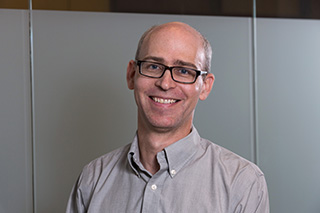Leading and Listening: Stabilizing the Faculty of Arts and Science research community
 When campus shut down one year ago, the senior leadership team was faced with a daunting task. Along with switching the academic year to an online model and working with staff as they transitioned to working at home, there was the Queen’s University research community to consider as access to research spaces was shut down.
When campus shut down one year ago, the senior leadership team was faced with a daunting task. Along with switching the academic year to an online model and working with staff as they transitioned to working at home, there was the Queen’s University research community to consider as access to research spaces was shut down.
Nicholas Mosey, Associate Dean (Research), had the task of determining how best to support the Faculty of Arts and Science researchers and what the days and months ahead might hold.
“The period between March 13 (when on-campus classes were discontinued) and April 23 (when non-essential on-campus research was stopped) was challenging,” says Dr. Mosey. “During this period, faculty members, department heads, and other administrators were trying to make the best decisions they could in the face of very limited information in an unprecedented situation, a global pandemic. This led to some inconsistent approaches being used to determine what research was permitted on-campus, with some units trying to maintain research to the greatest extent possible due to low local caseloads and other units stopping research altogether due to concerns about the emerging pandemic and similar decisions made at other institutions.”
To rectify this situation, Dr. Mosey explains, the university’s Research Response Team (which has representation from the Vice Principal Research’s office and the three largest faculties) decided to bring research to a consistent place across the university and develop a plan to permit access to campus for research purposes in a manner that was consistent with public health guidelines.
As part of the Research Response Team, Dr. Mosey helped develop a two-part process to stabilize the research community during the early stage of the pandemic.
- The first stage in standardizing the opportunity to conduct research on-campus involved pausing all research that was deemed non-essential. The decisions of whether an activity qualified as essential were made by the Associate Dean (Research) in each faculty to ensure that decisions could be made quickly to prevent delays.
- The second stage in standardizing the opportunity to conduct research on-campus involved the development and implementation of a plan that balanced the available research capacity on campus and the needs of our students, staff, and faculty to conduct research. This plan was implemented in late April and saw applications for access first reviewed by the Associate Dean (Research) in each faculty and then by the university’s research response team.
With those protocols in place, the Research Response Team was able to start planning for the next three, six, nine, and 12 months, though much was still unknown about how the pandemic would process and affect the community.
“The main development that occurred around three months into the pandemic was the transfer of decision-making regarding access for research from the research response team to the departments,” says Dr. Mosey. “This transition gave units greater control over access to their spaces. The procedures that departments followed to make decision regarding access were based on the policies developed by the research response team, illustrating how the decision to cease research in March and develop a clear plan to provide access to spaces easily facilitated the expansion of such access.”
Dr. Mosey points to the work of Project Manager Meghan Hatch who was critical in adapting the university’s policies into a set of consistent returns to campus documents for all the units in FAS.
At the six-month mark, more changes were made to accommodate students, staff, and faculty whose research did not require a presence on campus but were struggling to work remotely. Dr. Mosey and his team worked over the summer to expand access for those individuals, along with those who required access to prepare materials to teach remotely in the fall.
A lockdown from December to February again required restrictions to on-campus research but a plan had already been developed from the early days of the pandemic, so the transition went smoothly.
One year later, Dr. Mosey says he is optimistic and that the future looks positive in terms of a return to campus. He also recognizes the tremendous efforts of everyone involved in this process over the past year including researchers who have had their programs disrupted in ways that may impact their abilities to graduate on time, move on to new positions, or maintain momentum in research, staff members who have played a key role in taking care of many of the fine details required to develop and implement policies, and department heads who have been placed in very challenging positions where they’ve had to make decisions about how to preserve their departmental activities to the greatest extent possible while ensuring that public health guidelines are followed.
“I’m optimistic in terms of what we can learn from this experience,” says Dr. Mosey. “The pandemic laid bare some systemic issues within the institution that need to be addressed and doing this will make us a better institution even when we aren’t facing these extreme circumstances. Conversely, the need to work differently has also highlighted some new ways for us to conduct our work, which I hope will continue. While we cannot predict the future and conditions may require us to restrict access once again, I see light at the end of the tunnel.”
Read Part 1 of the Leading and Listening Series: The Community Speaks and Part 2: Support The People.

